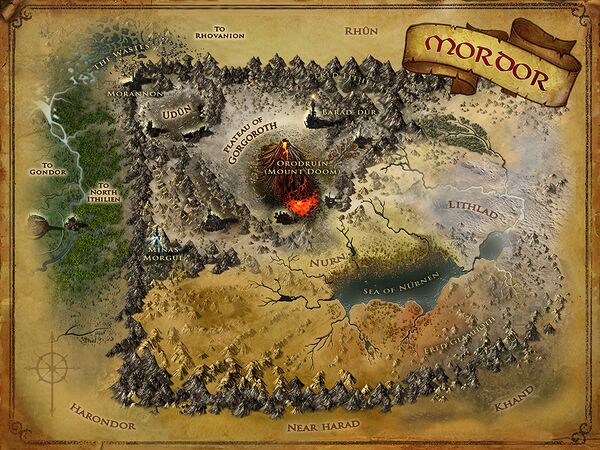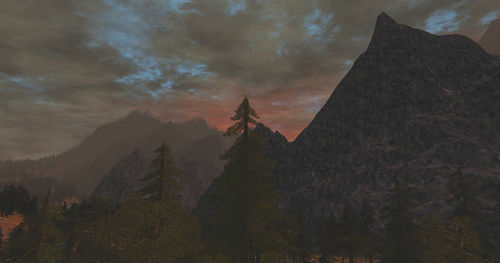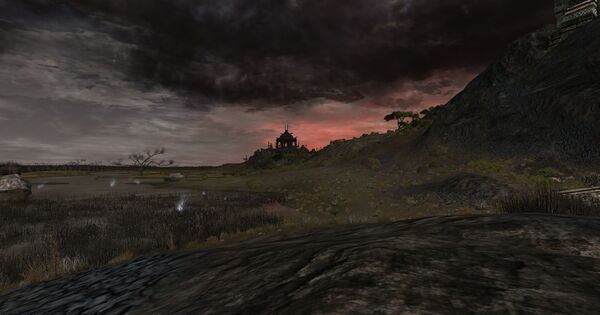Mordor

- "One does not simply walk into Mordor. Its black gates are guarded by more than just orcs. There is evil there that does not sleep, and the Great Eye is ever watchful.
It is a barren wasteland, riddled with fire, ash, and dust. The very air you breathe is a poisonous fume. Not with ten thousand men could you do this. It is folly."- — Boromir, The Lord of the Rings
- "One does not simply walk into Mordor. Its black gates are guarded by more than just orcs. There is evil there that does not sleep, and the Great Eye is ever watchful.
Description
- The area of Middle-Earth called Mordor is a relic of the devastating works of Morgoth before his banishment to the Void. Located in the southeast of Middle-earth to the East of the Anduin, the great river, it is the land covering the plateau formed by massive volcanic eruptions. In Sindarin it was given the name Mordor (the Black Land) before Sauron settled there, because of its volcano and its eruptions. Shelob had settled in Mordor long before Sauron.
- After the destruction of the strongholds of evil in the north of Middle-earth at the end of the First Age, Sauron fled southwards seeking new lands. At the end of the first millennium of the Second Age, he chose a land walled by mountains. To further fortify that land, to prevent invasion through the Pass of Cirith Gorgor he built the Morannon. It was built with the power of the One Ring, like his great fortress of Barad-dûr.
- At the end of the Second Age, after the defeat of Sauron by The Last Alliance of Elves and Men, Mordor was taken under the control of Gondor, and the Gondorians built fortifications around the Morannon, the Towers of the Teeth, to prevent the return of evil things. As Gondor's power faded, however, Mordor once again fell into the hands of the Enemy, and after two thousand years of relative peace, the Nazgûl returned and claimed the land once again in the name of Sauron. Sauron himself, however, dwelt at Dol Guldur in Mirkwood as the Necromancer, and did not himself return openly to Barad-dûr until some seventy years before the War of the Ring. The Nazgûl claimed Minas Ithil as their own, renaming it Minas Morgul.
- Mordor's geography is unique because of the three enormous mountain ridges surrounding it, on the North, the West and the South. These mountains both protected the land from an unexpected invasion by any of the people living in those directions and kept those living in Mordor from escaping.
- Frodo and Sam traveled through Mordor enroute to find the Crack of Doom in order to destroy the One Ring in the fires where it was forged.
Locations
- Ephel Dúath - the Mountains of Shadow - bordering North Ithilien and South Ithilien of Gondor on the west before swinging east to form the southern border of Mordor, separating Mordor from the Harad lands to the south. They were breached midway by the Morgulduin, a river of Gondor, forming the pass of Cirth Ungol.
- Ered Lithui - The Ash Mountains - Separating Mordor from Rhûn, this mountain range forms the northern border of Mordor, meeting with the Ephel Dúath to form the pass of Cirith Gorgor leading into the enclosed plain of Udûn. A spur of the Ered Lithui leads to the Plateau of Gorgoroth where Mount Doom and Barad-dûr are located.
- Cirith Gorgor - the gap between the Ered Lithui and the Ephel Dúath mountain ranges. Although called the Haunted Pass by men, the Elvish name literally means "pass of great dread." It was a narrow pass with sheeer cliffs on either side where the two mountain ranges met.
- Carach Angren - (Sindarin) or Isenmouth (Westron) - the pass between the small valley Udûn and the larger Plateau of Gorgoroth. It was formed where spurs of the ranges of the Ephel Dúath and the Ered Lithui met, leaving only a narrow passage between them.[1]
- Representing the passage to the Black Gate of the Morannon, Carach Angren was heavily fortified, and both the rocky spurs that overlooked it carried fortresses and watchtowers. Across the passage itself, a wall of earth had been built, and a great ditch had been dug across the opening spanned by a single bridge.[2]
- Both Carach Angren and Isenmouthe mean "Iron-mouth.
- Towers of the Teeth two guard towers were built by Gondor to keep a watch on this entrance to Mordor and the Morannon at the end of the Second Age after Sauron's defeat by The Last Alliance of Elves and Men.
- Mount Doom - "Orodruin in Sindarin" - the home of the Crack of Doom.
- The Plateau of Gorgoroth - Normally thought of as the gateway to Mount Doom. As there is no water or plant growth of any type, the area is uninhabited and a bit dusty.
- The Sea of Núrnen - The largest body of water in the region is located in the relatively fertile southern Nurn area. Desertification is a large problem here though, as is the water boiling off when near-molten boulders land in the lake.
Map


March of the King
March of the King is the name of a release in 2016. See Update 19: March of the King - October 18, 2016.
The name may refer to various things:
- This release comprised two regions: see Anórien (After Battle) and Ithilien for details of quests and other information.
- It is the name of a quest pack: See
 March of the King
March of the King
- It is the name of the deed group and tab in the deed finder. See March of the King Deeds.
- It is the name of a map that covers both regions:

Note: Originally the wiki had the the region set up as March of the King, but in game this is split in two as detailed above, and the wiki now matches this, which then accommodates other releases such as Minas Tirith (Midsummer) and the Allegiance quest system that happen after the march.
The Wastes

- See The Wastes for more details
The Wastes is a region that is situated immediately outside of Morannon, the Black Gate of Mordor. It lies above North Ithilien and north-west of Mordor. The is the site of a major battle at the end of the Second Age, when Mordor was first defeated, but the area was lost as Mordor regained strength. It has been long contested and is still occupied by Orcs and others ready to resist the march of the King.
- Level: 105
- Factions: Host of the West
- Crafting: Anórien (T10)
- Introduced: Update 20 - Battle of the Black Gate - March 21, 2017
- Free to VIP
- Quest Pack:
 Quest Pack: Battle of the Black Gate
Quest Pack: Battle of the Black Gate
| Lands of Middle-earth
| ||
|---|---|---|
| Eriador • Gondor • Haradwaith • Mordor • Rhovanion • Rohan |
| Regions within the Land of Mordor
| ||
|---|---|---|
| Mordor Besieged • Morgul Vale • The Plateau of Gorgoroth |
Template:North Ithilien Template:March of the King
| Settlements, Areas and Landmarks of The Wastes
| ||
|---|---|---|
| Areas: | Dagorlad (Morannon (War of the Last Alliance)) • (Lang Rhuven) • The Noman-lands • The Slag-hills (Battle of the Morannon) | |
| Settlements: | Camp of the Host • Haerondir • Small Ranger Camp | |
| Landmarks: | Tham Durlan • Nuiharn • Guard Tower Ruins • Store House Ruins • Merchant shop Ruins • Farm House Ruins • Inn Ruins • Noble's House Ruins • Stable Ruins • Carchost • Dol Acharn • Dûm Boha • Fushaum Gund • Narchost • Ondoher's Folly | |
| Interiors: | — | |
| Dungeons: | Skoironk • Towers of the Teeth | |
| Instances: | — | |